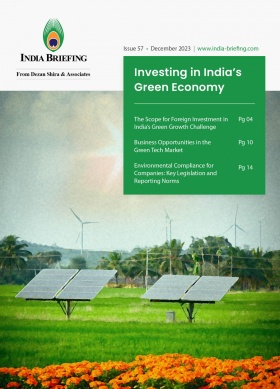More Women Are Now Part of India’s Expanding Manufacturing Workforce
To reach its 2030 economic goal of US$7 trillion, India must increase the proportion of women in its domestic manufacturing workforce. The World Bank estimates that India’s GDP growth would increase by 1 percent if the country’s female labor force participation rate rose from 25 percent, where it is now, to 50 percent. We discuss how leading industrial firms are making some progress in this area, even as overall female labor force participation in the manufacturing sector is quite bleak.
Efforts are underway to ensure greater representation of women in the Indian workforce. The country has been witnessing a gradual rise in the number of women entering its traditionally male-dominated manufacturing sector in recent years. Increasing the participation of women in factories and offices offer numerous advantages, including diverse perspectives, innovative solutions, a balanced organizational structure, and improved financial performance.
As India strives to attract more multinational companies (MNCs) to establish their manufacturing operations within its borders, the presence of a large, skilled labor force has been a key selling point. Yet, achieving gender parity in the workforce is crucial for India to realize its demographic potential, besides its goal of becoming the world’s third-largest economy by 2030.
Increasing the number of women in the workforce is therefore an essential change that must occur to propel India towards its economic objectives.
Webinar – India’s Manufacturing Landscape in 2024: Key Sectors, Challenges, Competitiveness, and Schemes
India Session: March 13, 2024
10:00 AM Brussels / 2:30 PM India Time / 4:00 PM Vietnam Time / 5:00 PM China Time
North America Session: March 14, 2024
9 AM Los Angeles / 12 PM New York / 6 PM Brussels
Join us as Koushan Das, Manager – Business Intelligence, shares insights on India’s manufacturing landscape in 2024 and highlights the importance of emerging sectors, competitiveness in Asia, the importance of MSMEs, and key industrial hubs in the country.
This webinar is FREE of charge.
Companies are hiring more women on factory floors
While India’s female workforce is primarily engaged in the unorganized sector, recent reports indicate that many MNCs are hiring women to be at the forefront of product manufacturing. For example, 72 percent of the approximately 100,000 direct jobs created in Apple’s India factory ecosystem by its vendors are held by women in different labor capacities.
With the primary motivation of expanding the talent pool, a growing number of Indian manufacturing firms are breaking down gender stereotypes by bringing more women onto the work floor. In 2023, Jayant Acharya, the chief executive and joint managing director of JSW Steel, stated that over half of the workforce at the company’s new color-coated steel manufacturing facility in Pulwama, Kashmir, will be female. It is anticipated that the unit will start operating this month.
Similarly, the Indian conglomerate Aditya Birla Group asserts that women make up over 50 percent of newly hired engineers on the shop floor. According to Santrupt Misra, group director of Birla Carbon and group HR head of ABG, there are other factors contributing to this trend, including a rise in automation, a loosening of laws allowing women to work night shifts in some states, and shop floor amenities that are conducive to women, such as childcare facilities and restrooms.
Even the automobile manufacturing sector in India is rapidly increasing its female workforce. Women make up roughly 23 percent of new hires at Tata Motors on the shop floor. In all of Tata Motors’ plants, over 4,500 women work on the factory floor, and over 1,850 of them assist in the assembly of trucks and buses, among other commercial vehicles. There are 1,600 women working three shifts at Tata’s Pune plant, which assembles the larger SUVs – Safari and Harrier.
When recruiting blue-collar workers for its production facility in Halol, Gujarat, in 2023, well-known automaker MG Motor India stated that the application responses were unexpected. The automobile brand observed that the female candidates showed great attention to detail, extraordinary precision in their work, and equal physical efforts in industries that are dominated by men. The company has employed women to perform quality testing and door and axle fitting.
In the meantime, both the central and state governments in India are weighing the significant role of female workers in the domestic manufacturing sector. India’s apex think tank body, NITI Aayog, says that Kerala and Odisha have the highest number of state-backed schemes in the manufacturing sector. These schemes are likely to also incentivize hiring more women on factory and shop floors.
In 2016, the Karnataka state government set up the first Women’s Park at Kalaburagi to facilitate women entrepreneurs open their manufacturing and processing units. In November 2021, the state announced four industrial parks dedicated to women at Mysuru, Dharwad, Kalaburagi, and Harohalli.
In a 2022 study titled “India’s Booming Gig and Platform Economy”, the Niti Aayog recommended that enterprises that offered livelihood chances where women make up a significant share of their workforce should be eligible for fiscal incentives like tax cuts or startup subsidies. At present, some states have introduced support programs for women in MSME sectors and startups, yet no full-scale or ambitious targets have been set.
Spotlight: Tamil Nadu’s women workforce in the manufacturing sector
In Tamil Nadu, women make up 43 percent of the workforce in India’s manufacturing sector. More businesses are employing women, particularly in the traditional leather, textile, and automotive industries, as well as in developing fields like electric vehicles, battery electronics, and solar cell manufacture.
The Annual Survey of Industries in 2019-20, released by the Union Ministry of Statistics and Programme Implementation, shows that 679,000, or 43 percent of the 1.58 million women employed in India’s industries are located in Tamil Nadu. The percentage of women working in the state is greater than the average for the country.
Under the Tamil Industrial Policy, 2021, the state government offers skilling support for resident workers and training subsidies for women and transgender employees for a period of six months. For foreign investors, incentives also cover R&D training.
Women-owned micro-enterprises in India
• A vast majority of women-owned micro-enterprises (71.5 percent) are engaged in manufacturing, and the rest in services and trading sectors.
• Women-owned micro-enterprises are concentrated in 10 sub-sectors of manufacturing, services, and trading. These sub-sectors account for over 90 percent of the women-owned micro-enterprises.
• There are an estimated 2.7 million women-owned very small enterprises (WVSEs) in India.
|
Top 10 Sub-Sectors for Women-Owned Micro-Enterprises |
|||
|
S. no. |
Name of sector |
Activity |
Share of enterprise |
|
1 |
Manufacture of wearing apparel |
Manufacturing |
26.4% |
|
2 |
Manufacture of tobacco products |
Manufacturing |
22.6% |
|
3 |
Retail trade |
Trading |
15.7% |
|
4 |
Manufacture of textiles |
Manufacturing |
10.8% |
|
5 |
Community, social and personal services |
Services |
4.5% |
|
6 |
Educational services |
Services |
3.8% |
|
7 |
Manufacture of food products |
Manufacturing |
2.6% |
|
8 |
Other manufacturing (including jewellery and bijouterie) |
Manufacturing |
2.6% |
|
9 |
Manufacture of wood products |
Manufacturing |
2.2% |
|
10 |
Food service activities (eateries) |
Services |
2.1% |
|
Periodic Labour Force Survey in India (2022-23): Estimated Percentage Distribution of Workers by Industry |
||||
|
Broad industry division as per NIC 2008 |
Rural |
Urban |
||
|
|
Male |
Female |
Male |
Female |
|
Agriculture |
49.1 |
76.2 |
4.7 |
11.7 |
|
Mining & Quarrying |
0.4 |
0.1 |
0.6 |
0.1 |
|
Manufacturing |
8.2 |
8.3 |
20.5 |
23.9 |
|
Electricity, water, etc. |
0.5 |
0.1 |
1.3 |
0.5 |
|
Construction |
19 |
4.2 |
12.6 |
3.1 |
|
Trade, hotel & restaurant |
10.5 |
4.1 |
26.5 |
15.2 |
|
Transport, storage & communications |
5.3 |
0.2 |
13.2 |
5.5 |
|
Other services |
7 |
6.9 |
20.6 |
40.1 |
|
Total |
100 |
100.1 |
100 |
100.1 |
Data: Ministry of Statistics; PLFS 2022-23
To minimize obstacles for women that are exacerbated by issues related to physical safety, India’s Code on Occupational Safety, Health, and Working Conditions (OSH), 2020, allows women to work in aboveground mines, including opencast mines, between the hours of 7 p.m. and 6 a.m. and in belowground mines, between the hours of 6 a.m. and 7 p.m., in technical, supervisory, and managerial positions where constant presence may not be necessary.
The OSH Code will come into effect after states issue implementation guidelines.
In 2023, the state government of Odisha announced its decision to establish a center of excellence (CoE) dedicated to robots and artificial intelligence (AI). The higher education department started the process of establishing the center at Rama Devi Women’s University as part of this exercise, at an approximate cost of INR 80 million (US$966,406). This presents a huge opportunity for women to work in R&D and frontier technology roles.
Challenges
With the manufacturing sector making up 16-17 percent of the country’s GDP, there is a clear gender gap in this industry. Women only make about 12 percent of the workforce in the manufacturing sector. Despite a slight increase from 8 percent in 2019 to 12 percent in 2021, the proportion of women in manufacturing operations is still woefully low.
Further, per a report analysis from 2022, out of a total 73.2 million micro, small, and medium enterprises (MSMEs), women-owned enterprises constituted only 14.9 million (20.4 percent), of which over 70 percent are manufacturing enterprises.
Despite several initiatives at the governmental and industrial levels, there is still much work to be done to encourage more women to pursue careers in manufacturing – from overcoming biases in families and businesses to facilitating education and skilling.
Finally, to effectively break glass ceilings and have more gender parity in the workforce, women need opportunities to reskill and upskill, particularly in fields that are essential to the economy, such as manufacturing, and specialist fields like artificial intelligence and data science that have multisectoral application.
About us
India Briefing is produced by Dezan Shira & Associates. The firm assists foreign investors throughout Asia from offices across the world, including in Delhi and Mumbai. Readers may write to india@dezshira.com for more support on doing business in India.
We also maintain offices or have alliance partners assisting foreign investors in Indonesia, Singapore, Vietnam, Philippines, Malaysia, Thailand, Bangladesh, Italy, Germany, Australia, and the United States.
- Previous Article Risks for US Businesses in Emerging Asian Markets in 2024
- Next Article NFRA Seeks to Promote Innovation in India’s Auditing Industry










